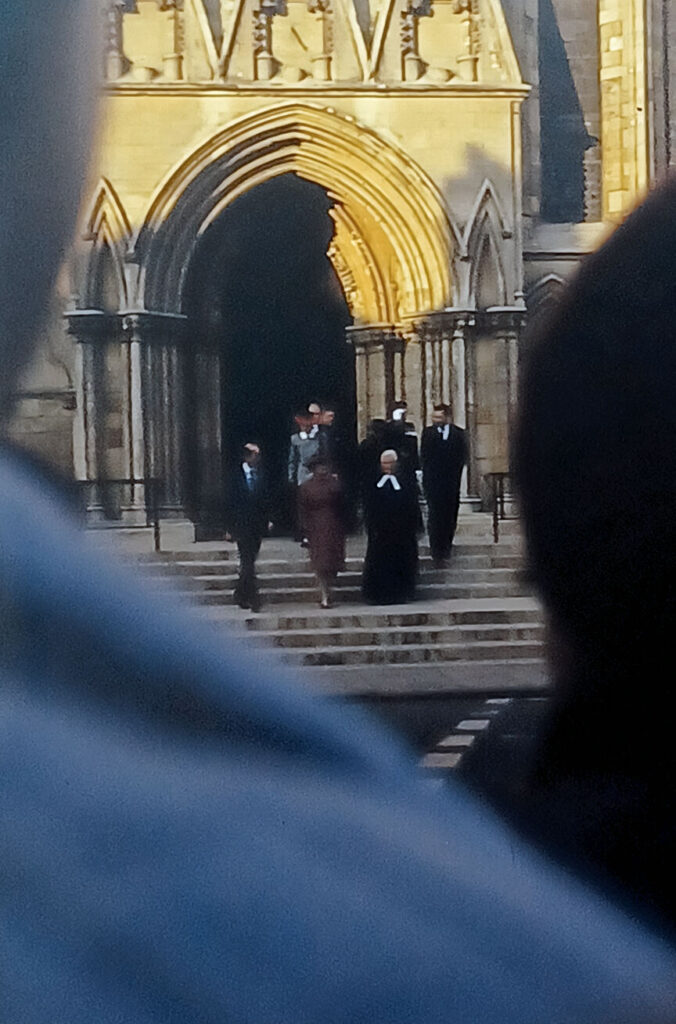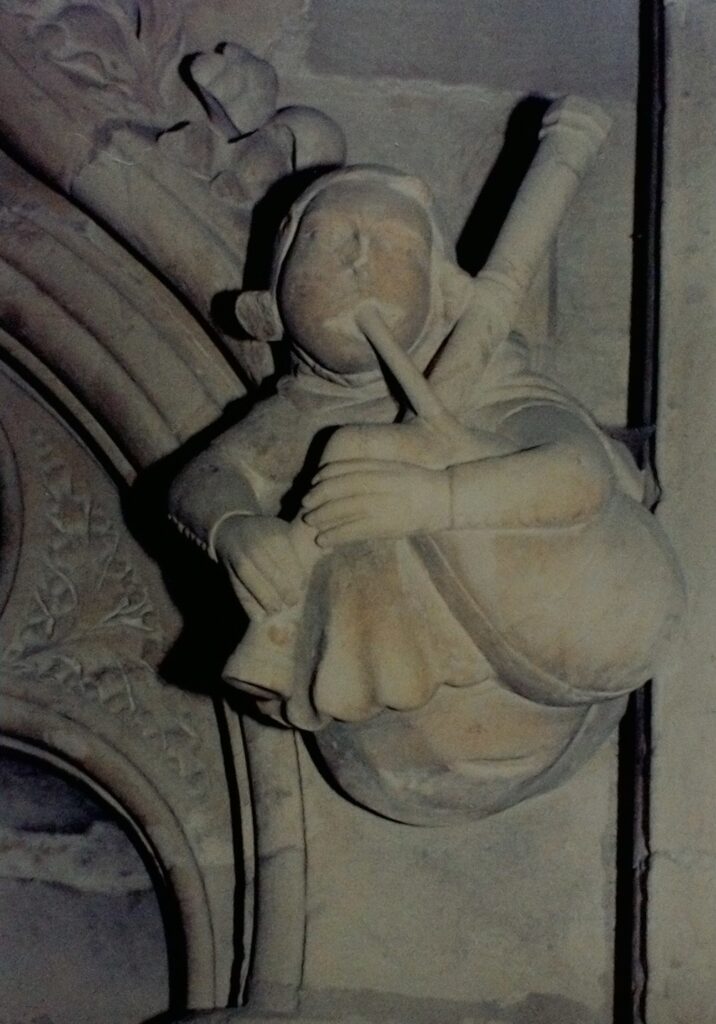The Chapter House and Mason’s Loft in York Minster are setting for my novel, The Stonemason’s Secret. Learn more about their history and how they are used in the story.
Perched atop a hill in York, England is The Cathedral and Metropolitan Church of St Peter in York. Commonly known as York Minster, it is the largest medieval Gothic cathedral by volume in England and larger than many in Europe. Like most medieval cathedrals, it took hundreds of years to complete. You can document the passage of time by changes in architectural styles.

I visited York many times during the year I lived in England, and those visits often included a stop at the Minster. I spent hours roaming the building, taking in the medieval stained-glass windows and the stone carvings that decorate many of the surfaces.

In November 1988, the south transept reopened following repairs after a fire. The ceremony was attended by Her Majesty, Queen Elizabeth II, and I stood across the street as she left via the south transept.
It should be no surprise that I chose York Minster as a setting in The Stonemason’s Secret.
While the characters visit several parts of the church, the action centers on two areas: the Chapter House and the Mason’s Loft.
York Minster Chapter House
Built during the second half of the 13th century, the Chapter House is located north of the choir. Access is through a vestibule from the north transept. This interactive map gives an overview of the Minster and where the Chapter House (#5) is located.
Chapter Houses served as a meeting room where the church or monastery conducted business. Often attached to the church buildings, chapter houses came in a variety of shapes. York’s Chapter House is octagonal, as are the ones at Westminster Abbey, Salisbury, and Wells. The Chapter House at Canterbury Cathedral is rectangular.
An octagon-shaped building usually needs a central pier to support the ceiling and keep it from falling, but York’s Chapter House doesn’t have one. Instead, the ceiling stays up because of two design elements. The star-shaped ribbed vaulting was quite an engineering feat for the time. The interior supports of the roof were constructed of timber, much lighter in weight than the usual stone.
Decoration in York Minster Chapter House
There is a lot to look at in the York Chapter House. Stained-glass windows fill the upper 2/3rds of seven of the walls, while the eighth wall, above the doorway, is carved to match the tracery of the windows.
Along the lower 1/3rd of the walls are the highly carved stalls containing the seats for chapter members. A vaulted canopy is over each stall, and carved heads, animals, and foliage adorned the walls over and between them. If a chapter member became bored with the business being conducted, they had plenty to look at!
Stylistic Connections Between York Minster and Beverley Minster
Beverley is about 25 miles southeast of York. Many masons that worked at Beverley came from York Minster, bringing stylistic trends with them.
The Chapter House at Beverley was octagonal, like York’s. Destroyed during the Protestant Reformation in the 16th century, all that remains are the stairs leading to it in the north choir aisle of the Minster. It is not known if there was a central pier or not.
Several of the carved heads in the York chapter house have eyes where the center was drilled to represent the iris. The same detail is on a handful of the minstrel carvings along Beverley Minster’s north aisle.

You can see more images of York Minster Chapter House on a Pinterest board I created.
The Mason’s Loft at York Minster
When I began writing the scenes set in York Minster, I visited the York Minster website. It had been 30 years since I was there and needed to refresh my memory.
I discovered the Minster now offers tours of the Hidden Minster, and one of those was to the Mason’s Loft.
The Mason’s Loft? I had no memory of that part of the Minster. Could I have somehow missed it on my many visits?
More internet searches provided an answer. The Loft is on the level above the Chapter House vestibule and follows the same L-shaped floor plan. Over time, it was more-or-less forgotten about. During the late 1990s, repairs to the vestibule reopened the Loft and led to a thorough investigation. After the research was completed, the area opened for special tours. You can see the vestibule connecting the north transept and the Chapter House on the interactive map of the Minster.
No wonder I didn’t know about the Mason’s Loft; it hadn’t been rediscovered when I was there. Returning to my book, I wondered how I could use the space in The Stonemason’s Secret. Since the story revolves around clues left by Beverley Minster’s master mason, who previously worked at York, it seemed a perfect connection.
Purpose of the Mason’s Loft
The lack of records regarding the Loft has led to debate. It is uncertain whether the loft was part of the plan when the vestibule was built or if it was a later addition. There is also debate over the original purpose of the space. We do know the Loft was completed in the 1290s and used as a tracing room from the beginning.
The Loft was where the Master Mason created designs for templates. Thin layers of plaster of Paris covered the floor in one area, which the mason used to create the designs. Next, the mason transferred the designs to thin wood or metal templates. These went down to the stone yard for use by the masons. The tracing floor still shows designs etched into it centuries ago; some of them can be identified in the Minster and other nearby churches.
Features of the Mason’s Loft
Access to the Mason’s Loft is up a circular stairway built into the west wall of the Chapter House. After a climb of 87 steps, you enter the Loft where there are Victorian examples of templates hanging on racks. The exit to the Chapter House roof is on the left. Around the corner, on the other section of the L, is the tracing floor. Along one wall is a garderobe. This was an early toilet that was flushed as rainwater ran off the roof. Some of the roof timber is original, the wood dating before the 1290s.
You can see more images on my Pinterest board.
The Chapter House and Mason’s Loft aren’t the only locations in the Minster in The Stonemason’s Secret. I also have characters explore parts of the nave, the south transept ceiling, and the central crossing. There is even a chase scene where the good guys are chased out of the Chapter House, through the nave, and escape through the gift shop.
There are many other things to see when visiting York Minster. Allow plenty of time to take in all the sites, and plan to go on some of the special tours for a behind-the-scenes look.
You can learn more about The Stonemason’s Secret and explore other aspects of the art and history in it on this page.
Want to learn more about The Stonemason’s Secret? Join my VIP Readers Group to be notified of new blog posts, publication updates, and exclusive downloads!
